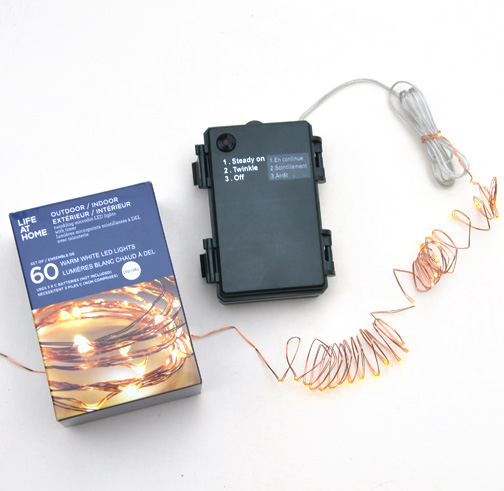Happy holidays everyone! The two younger boys and I have been having fun playing in the white stuff.
Despite what the seasonal calendar says, winter arrived a little over 2 weeks ago with a snow storm that hit its peak right at the 5 pm rush hour. We live in a deep river valley with a rollercoaster-ride-of-a-hill on one side and a steep slope that would be perfect for sledding on the other. Cars don't fair well on either of the two hills when there is a storm. Our street was a parking lot for hours. No one could get out of the valley.
Other than shovelling, my spare time in the weeks leading up to Christmas was filled with wrapping gifts, baking and decorating for the holidays. I thought I would share a couple of the wreaths I made this year. Both make use of strings of little fairy (LED) lights.
The start of the first decorating project was a plain evergreen wreath from the grocery store.
To illuminate it, I used two strings of lights from the dollar store. Here's how I put it together:
Step 1: I turned the wreath over to the wire frame at the back. Then I passed the first string of lights through an opening in the greenery to the front of the wreath. I left the string of lights hang loosely at the front of the wreath for now. Then I turned the wreath back over and attached the first battery pack to the wire frame with some green florist's wire.
Step 2: Now we are going to attach the second string of lights in the same manner. It is critical to balance out the back of any wreath so it will sit flat to your door. With a fresh piece of wire, I attached the second battery pack on the opposite side of the wreath.
Step 3: I turned the wreath over to the front and roughly placed my strings of lights in amongst the foliage. I ran the first string of lights clockwise around the wreath and the second string of lights counter-clockwise.
Once I was happy with the placement of my lights, I used some florists wire to hold them in place. To do this, I used loops of wire that I twisted closed on the back of the wreath.
Step 4: If your wreath was as basic as mine, you may want to augment it with more greenery, berries, pinecones and a bow. That's just what I did next.
Here's the first finished wreath. You can't see the glow of the lights really well in the daytime, but at night the they shine nicely.
One important thing to note: These cheap LED light strings are for indoor use only. I have a covered porch and a screen door with a glass front, so I was able to get away with using indoor lights. If your door is exposed, this type of light string may or may not short out in wet weather.
For the wreath I made for the back door, I used three strings of lights. There are two LED sets ($2.50 each from Walmart) and a string of larger stars ($5 from the Real Canadian Superstore).
This time the 3 battery packs were placed in thirds by dividing the wreath circumference into three equal parts. Again, it is critical to balance out the back of the wreath so it will sit flush to the door.
Step 1: The first step is to attach the two strings of mini-lights. (The third string of lights will go on later after the greenery is attached. If you try this, make sure you space the battery packs so you leave room for the third battery pack that you will add later).
To work my lights through the maze of grapevines, I used a pencil and poked it into the the vines to create a gap. Then I worked each of the lights up through those gaps. Once the pencil is removed, the gaps disappear.
Step 2: Next add your greenery to the front of the wreath, some berries and a bow. (Tuck the greenery right into the vines. Loops of florist's wire can then be added to hold it securely in place.)
Step 3: Turn your wreath over to the back and attach the third battery pack for the larger string of lights with two loops of wire. Flip the wreath back to the front and roughly place the lights using the greenery to conceal the wire for the lights. Using more loops of florist's wire secure this final string of lights to the wreath.
If you are having trouble disguising some of the wires, add a few more pieces of greener to conceal them.
I am especially happy with the way this one turned out.
Again, these light strings are for indoor use only. The back door has screen door with a glass front, so I was able to get away with using indoor lights. If your door is exposed, these type of lights might short out in wet weather.
Outdoor strings have larger, more weatherproof battery packs, but it's hard to work with the larger sized packs. As an experiment I made a wreath for the back gate using strings of indoor LED lights. It held up remarkably well and shone every evening through the holiday season.
Have fun decorating for the holidays!
























































